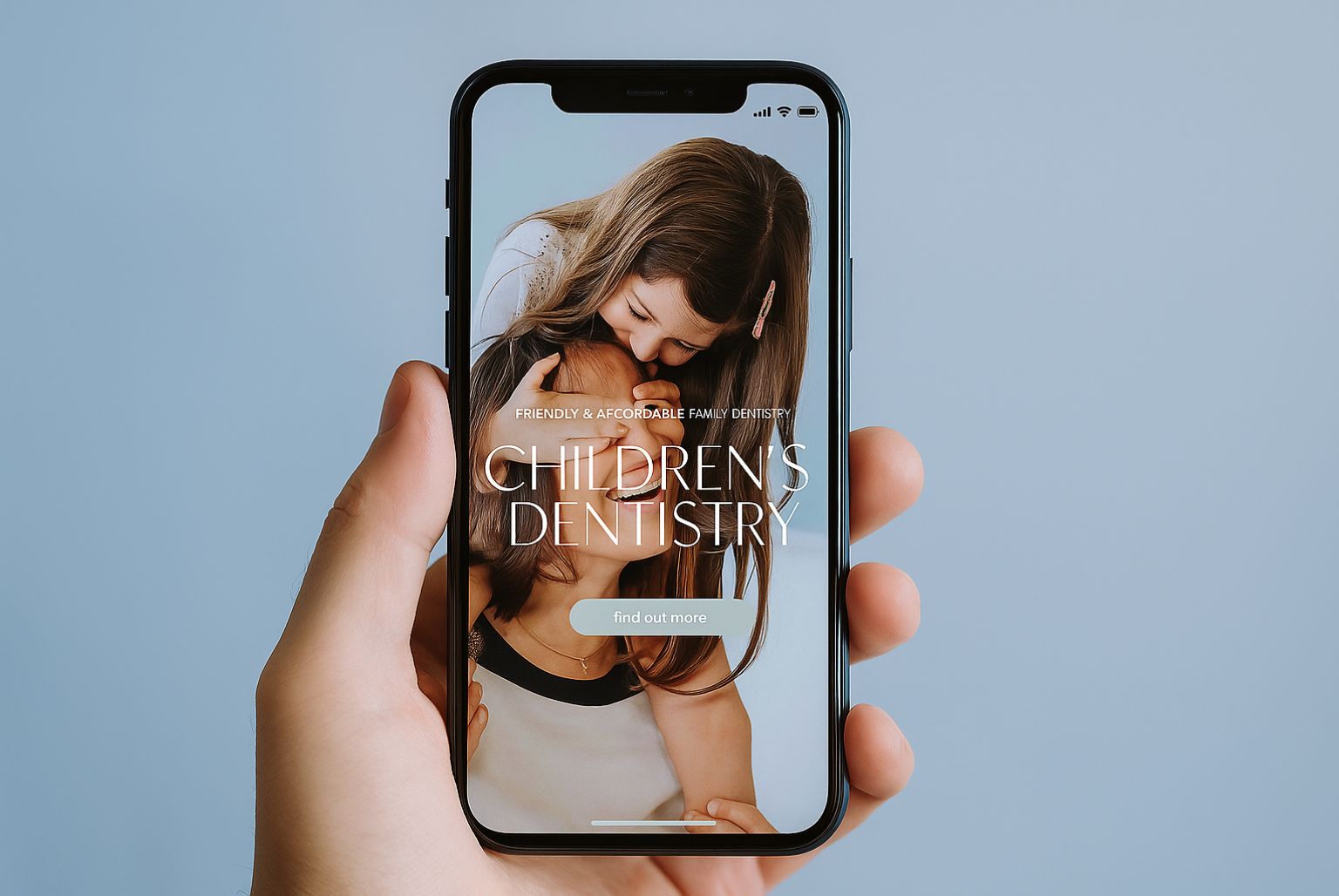With over 71% of UK dental patients searching for a new dentist online and NHS access continuing to decline, private practices face both a challenge and an opportunity. Whether you focus on general dentistry or cosmetic treatments like Invisalign, veneers, and whitening, standing out in a crowded market requires smart, targeted marketing.
This guide shares 22 proven dental marketing ideas tailored to the UK market, supported by real stats and patient behaviour insights.
Build a High-Converting Dental Website
Good web design isn’t just about looking modern—it directly influences whether a potential patient decides to trust you. A professionally designed site conveys credibility, warmth, and expertise. Clean layouts, easy navigation, and consistent branding help guide users smoothly through your services and toward conversion. A cluttered or outdated site, on the other hand, can lead to lost bookings and lower trust. Prioritise intuitive design that aligns with your practice’s tone and audience.
Your website is often the first impression a potential patient has of your practice. A clean, mobile-responsive, and professionally designed site builds trust, showcases your treatments, and makes it easy to take action. Include clear calls to action, online booking options, treatment pricing or finance info, team bios, and before-and-after galleries.
SEO for Dentists
Search Engine Optimisation (SEO) is one of the most effective long-term strategies for driving free, high-quality traffic to your dental website. A well-optimised website that ranks highly for local and treatment-related search terms (e.g., “Invisalign York,” “private dentist in Manchester”) will generate new leads month after month. Focus on creating location-specific landing pages, publishing useful blogs, and earning backlinks from relevant directories and local websites. Ensure your Google Business Profile is up to date and matches your website details to improve local SEO visibility.
Google Search Ads
Google Search Ads are one of the most effective channels for attracting new private dental patients. By targeting high-intent keywords like “private dentist near me,” “Invisalign in [location],” or “cosmetic dentist London,” you can appear at the exact moment people are looking for treatment. With features like location extensions, call buttons, and review highlights, these ads offer excellent visibility and conversion potential. Make sure to track phone calls and online bookings to properly measure ROI and continuously optimise performance.
Local Awareness Ads on Meta (Facebook & Instagram)
Targeting your ads geographically is essential. Meta’s advertising platform allows you to run Local Awareness campaigns across both Facebook and Instagram. These platforms let you promote your dental practice to users within a set radius of your clinic, with features like call buttons, map cards, “Get Directions” links, and more. This is especially powerful for mobile users actively searching for nearby services and can help drive real-time enquiries for new patient appointments.
Click-to-Call Google Ads
Patients searching for a dentist—especially for emergency needs—often want to call immediately. Click-to-call extensions in Google Ads boost conversion rates significantly for mobile users. It’s an essential ad type for high-intent keywords like “emergency dentist near me.”
Mobile-Only Call Ads
Since most healthcare searches now happen on smartphones, mobile call-only campaigns are a powerful way to capture patients who are ready to book immediately. These work well when paired with location-based and emergency-related keywords.
Facebook Demographic Targeting
Facebook allows detailed targeting based on gender, age, parental status, household income (estimated), and interests. Given that women make up around 90% of dental healthcare decision-makers, targeting local mothers, especially those interested in children’s products, can be highly effective.
Creating Regular Blogs
Publishing regular blog content on your dental website can significantly improve your SEO footprint and keep patients engaged with your brand. A blog allows you to target more keywords (answering patients’ common questions) and demonstrate expertise, which in turn drives traffic and builds trust. Data shows the clear benefits of blogging:
- More website visitors. Businesses that maintain an active blog see a 55% increase in website visitors on average compared to those that don’t blog. Each new blog post is a fresh page that can rank in search engines (for example, a post about “how to ease a toothache” could attract someone searching for that problem). More indexed pages and topics mean more chances to attract potential patients to your site.
- More leads and conversions. Blogging isn’t just about traffic, but traffic can translate to more leads. For a dental practice, those leads could be appointment requests or new patient calls. By providing useful, relevant information (like dental hygiene tips or explaining procedures) in your blog, you nurture readers into trusting your practice and eventually converting.
- SEO advantages through content and backlinks. Quality blog content naturally earns backlinks from other sites (for instance, a local mommy blog linking to your post on kids’ dental health). Businesses with blogs get 97% more inbound links to their websites on average. These backlinks boost your site’s domain authority, which is a factor in Google rankings. In short, a blog filled with informative articles improves your search visibility and gives patients a reason to stay on your site longer (lowering bounce rate and increasing engagement).
Automated Appointment Reminders
Consistent recall systems via email or SMS are key to keeping patients engaged. Practices that use reminders typically have an 80%+ recall rate. Automated systems reduce no-shows, encourage check-ups, and improve lifetime value.
Google Ads Income Targeting
Use household income targeting to promote specific treatments. For example, target higher-income brackets with Invisalign, veneers, and implants, and use broader targeting for basic check-ups and hygiene appointments.
Remarketing Ads (Google & Meta)
48% of dental patients in the UK spend two weeks or more researching before choosing a dentist. Remarketing keeps your practice visible to those who have visited your website but haven’t booked—perfect for nudging them to return with a special offer or reminder.
Facebook Messenger Ads
With Messenger Ads, patients can tap an ad to start a live chat with your reception or treatment coordinator. This provides instant access for people with questions, helping convert prospects who may be nervous or hesitant.
Google Maps Advertising
Appearing on Google Maps with a paid listing boosts your visibility dramatically. This is especially useful for mobile searches. Add CTAs like “Call now” or “Get directions” to convert people looking for local care.
Waze Local Ads
As of September 1, 2023, Waze discontinued its standalone advertising product, and advertisers can no longer purchase new ads directly through Waze. Google is in the process of integrating Waze’s advertising system into Google Ads technology. However, as of now, Waze inventory is not available through Google Ads platforms like Display & Video 360. Google has indicated that they are working on transitioning Waze Ads to Google Ads technology and plan to offer a new Waze Ads product in the future.
Target Emergency Dental Keywords
High-intent keywords like “emergency dentist near me” or “urgent tooth extraction” have huge ROI potential. Patients in pain are often ready to book immediately. Ensure your ads have a call button and clearly state your emergency availability.
Register on Doctify or Top Doctors
Instead of ZocDoc (US-based), UK dentists should claim listings on Doctify or Top Doctors. These platforms improve visibility and trust, especially among younger patients looking for private healthcare options.
Optimise Google Reviews, Not Yelp
77% of UK patients use online reviews to help choose a dentist, and Google Reviews are the #1 place they look. Ask happy patients to leave reviews, and respond to every review to show engagement and professionalism.
Instagram for Before & Afters
Instagram is perfect for showcasing cosmetic treatments like Invisalign, whitening, and bonding. Regularly post before-and-after images, reels of smile transformations, and patient testimonials to build trust and visibility.
Email Marketing Campaigns
Email isn’t just for reminders—it can drive reactivations, promote special offers, or deliver oral health tips. Patients on dental plans or who receive regular updates are more likely to return for check-ups.
Patient Referral Bonuses
Referral marketing works because 79% of UK patients value personal recommendations. Offer small rewards (like a £10 voucher or whitening discount) to patients who refer family and friends.
Video Marketing
Create short videos that introduce your team, explain treatments, or share patient stories. Video builds familiarity and trust—especially important for nervous or first-time patients.
Direct Mail for Older Audiences
Direct mail still works well, especially for reaching older, higher-income households. Send postcards highlighting new patient offers, cosmetic treatments, or smile makeovers.
Sponsor Local Events or Schools
Sponsor local sports teams or school events and include dental health kits or vouchers. One UK practice found 70% of families switched to their clinic after a local school outreach campaign.
Final Thoughts
Dental marketing isn’t just about getting more patients—it’s about getting the right ones and keeping them long-term. The most successful private practices in the UK understand who their patients are, what they value, and how to meet them where they are—online, in their inboxes, and in their communities.
Use these strategies to build a steady flow of new patients while deepening loyalty with the ones you already have.




